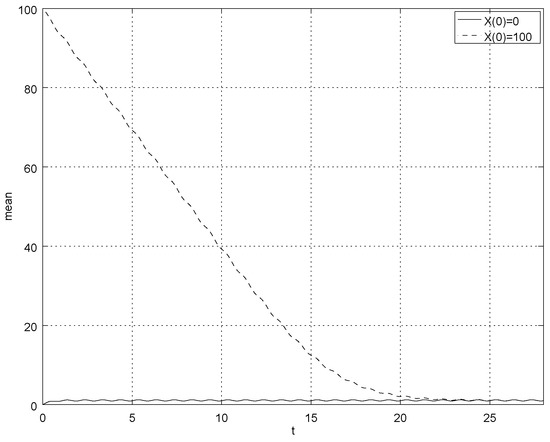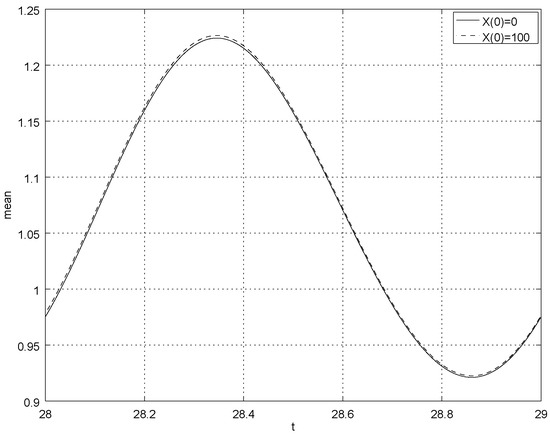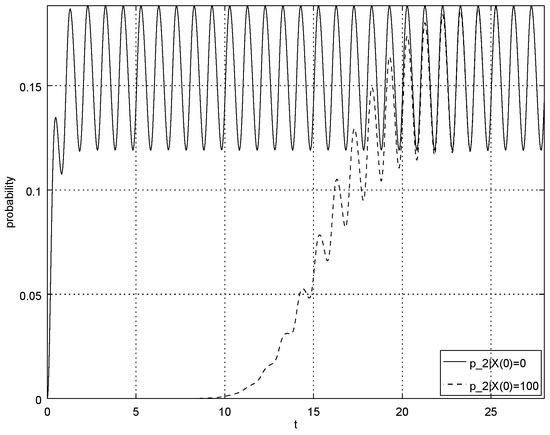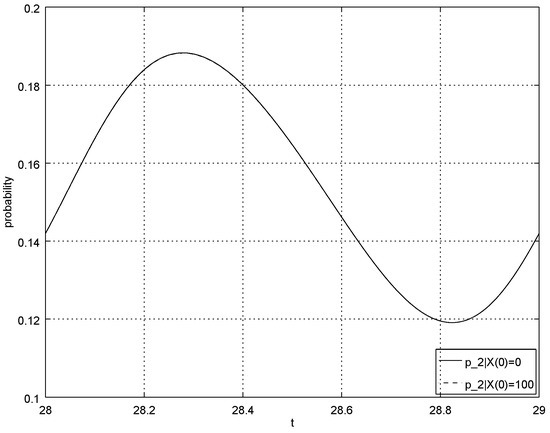Abstract
We apply the method of differential inequalities for the computation of upper bounds for the rate of convergence to the limiting regime for one specific class of (in)homogeneous continuous-time Markov chains. Such an approach seems very general; the corresponding description and bounds were considered earlier for finite Markov chains with analytical in time intensity functions. Now we generalize this method to locally integrable intensity functions. Special attention is paid to the situation of a countable Markov chain. To obtain these estimates, we investigate the corresponding forward system of Kolmogorov differential equations as a differential equation in the space of sequences .
1. Introduction
In this paper we consider the problem of finding the upper bounds for the rate of convergence for some (in)homogeneous continuous-time Markov chains.
To obtain these estimates, we investigate the corresponding forward system of Kolmogorov differential equations.
Consideration is given to classic inhomogeneous birth–death processes and to special inhomogeneous chains with transitions intensities, which do not depend on the current state. Namely, let be an inhomogeneous continuous-time Markov chain with the state space . Denote by , , the transition probabilities of and by —the probability that is in state i at time t. Let be probability distribution vector at instant t. Throughout the paper it is assumed that in a small time interval h the possible transitions and their associated probabilities are
where , for any . We also suppose that the transition intensities are arbitrary non-random functions of t, locally integrable on and, moreover, that there exists a positive number L such that
for almost all . Then the probabilistic dynamics of the process is given by the forward Kolmogorov system
where is the transposed intensity matrix i.e., , .
We can consider (2) as the differential equation with bounded operator function in the space of sequences (see details, for instance in [1]) and apply all results of [2].
Throughout this paper by (or by if ambiguity is possible) we denote the -norm, i.e., and . Let be a set of all stochastic vectors, i.e., vectors with non-negative coordinates and unit norm. Then for almost all , and implies for any .
Recall that a Markov chain is called weakly ergodic, if as for any initial conditions and , where and are the corresponding solutions of (2).
We consider, as in [3], the four classes of of Markov chains with the following transition intensities:
(i) for any if and both and may depend on i;
(ii) for , may depend on i; and , , depend only on k and does not depend on i;
(iii) for , may depend on i; and , , depend only on k and does not depend on i;
(iv) both and , , depend only on k and do not depend on i.
Each such process can be considered as the queue-length process for the corresponding queueing system .
Then type (i) transitions describe Markovian queues with possibly state-dependent arrival and service intensities (for example, the classic queue); type (ii) transitions allow consideration of Markovian queues with state-independent batch arrivals and state-dependent service intensity; type (iii) transitions lead to Markovian queues with possible state-dependent arrival intensity and state-independent batch service; type (iv) transitions describe Markovian queues with state-independent batch arrivals and batch service. We can refer to them as a queueing model following the original paper [4], see also [3,5,6].
2. Preliminaries
The problem of estimating the rate of convergence, like the very fact of convergence, is very important for studying the long-run (limiting) behavior of continuous time Markov chains with time varying intensities, see detailed discussion, examples and references in [7]. The simplest and most convenient for studying the rate of convergence to the limiting regime is the method of the logarithmic norm, see, for example [1,3,8].
However, there are situations in which this approach does not give good results.
Next, we show the possibility of using a different approach in such cases, namely the method of differential inequalities.
Another (but similar) approach is to use piecewise-line Lyapunov functions, see, for example, [9,10,11,12].
Consider here the two simplest examples of bounding the rate of convergence for differential equations.
Let firstly
be a system of differential equations with , and . Put , and . Then , both column sums for equal to . Hence the logarithmic norm equals , and we obtain a sharp upper bound on the rate of convergence . Such a situation is typical if the matrix of the considered system is essentially non-negative (i.e., all off-diagonal elements are non-negative for any ). Note that the corresponding eigenvalues of P are .
On the other hand, let . Then corresponding eigenvalues of P are . On the other hand, the “weighting” logarithmic norm P is not less than 1. In principle, here it is also possible to reduce the matrix to the exact value of the logarithmic norm (), see [2], but the corresponding transformation will be complex and difficult to implement. The best result () here can be obtained using the Lyapunov function (which does not work well in a countable situation), but the use of differential inequalities gives us an estimate like for any positive , see the corresponding description below, in Section 4. This approach deals with the sums of the columns for various combinations of the signs of the coordinates of the solutions of the system; it is described further in Section 4. It was first proposed in our recent papers; see [3] for the case of finite Markov chain with analytical (in t) intensities.
In this paper, it is shown that this method can be applied in a more general situation of locally integrable intensities, and, which is most difficult, for a countable chain that does not lend itself to direct reasoning and requires rather fine approximation estimates.
3. Explicit Forms of the Reduced Intensity Matrices
Let be the difference of two solutions of system (3), and . Then, in contrast to the coordinates of the vector , the coordinates of the vector have arbitrary signs.
Consider now the ‘homogeneous’ system
corresponding to (3). As was firstly noticed in [13], it is more convenient to study the rate of convergence using the transformed version of given by , where T is the upper triangular matrix of the form
Let . Then the system (5) can be rewritten in the form
where is the vector with the coordinates of arbitrary signs. If one of the two matrices or is known, the other is also (uniquely) defined.
The approach based on the differential inequalities (see [3]) seems to be the most general. On the other hand, if is essentially non-negative (i.e., all off-diagonal elements are non-negative for any ), then the method based on the logarithmic norm gives the same results, but in a much more visual form, see [3].
Let us write out the form of the matrix for each class of chains; in more detail, the corresponding transformations can be seen in [3].
For belonging to class (inhomogeneous birth–death process) one has
For belonging to class (which corresponds to the queueing system with batch arrivals and single services), one has
For belonging to class (which corresponds to the queueing system with single arrivals and group services), one has
Finally, for belonging to class (which corresponds to the queueing system with state-independent batch arrivals and group services), one has
where
Remark 1.
Generally speaking, for models of the first and second classes, the matrix is always essentially non-negative; at the same time, for models of the third and fourth classes, this requires some additional assumptions. Under essential non-negativity of all bounds on the rate of convergence can be obtained via logarithmic norm, see [3]. However, in the general case, this approach may not work, and the method of differential inequalities described in our previous papers, see [3,14], would be more effective.
Thus, in this paper we will consider chains of the third and fourth classes with a countable state space. For simplicity of calculations, we will additionally assume that the size of the simultaneously arriving and/or servicing group of customers does not exceed some fixed number, say R, i.e., that all for and any .
Let be a sequence of non-zero numbers such that . Denote by the corresponding diagonal matrix, with the off-diagonal elements equal to zero. Let in (7), then we obtain the following equation
where
If we write out , then
and our assumption implies for any if .
4. Upper Bounds on the Rate of Convergence
Let us first consider a general finite system of linear differential equations, which we will write in the form
where , and let D now be the corresponding finite diagonal matrix.
The simplest situation with analytical (in t) coefficients has been studied in [3,14,15]. The method of estimating under such assumption is based on the fact that, in this case, on any finite interval, each coordinate has a finite number of sign changes, which means that the semiaxis can be divided into intervals, on each of which the signs of the coordinates are constant. Consider such an . Choose the signs of -s so that all . Hence can be considered as the corresponding norm.
Let , for any j, then
Then
for the corresponding matrix D and corresponding function . Hence, we have
for any , and by continuity, for all .
Let now be arbitrary, . Then for any interval with fixed signs of coordinates we have bound (18) with the corresponding D and . Let now , and , where the minimum and maximum are taken over all possible combinations of coordinate signs of the solution , for any . Then we obtain the following general estimate
Let there exist positive numbers such that
Consider now an arbitrary interval ; if our original coefficients are locally integrable, they can be approximated arbitrarily accurately by a continuous functions. In turn, a continuous function can be approximated arbitrarily accurately by an analytic function. As a result, instead of the integrable , we obtain an analytic , such that
Denote now by and the Cauchy operators for (15) and the respective system with matrix . Then, if (20) holds, in accordance with Lemma 3.2.3 [2] (see [2], pp. 110–111) we obtain
Hence we have the following statement.
Lemma 1.
Let us now return to a countable system (7) and consider the corresponding truncated system
where .
Below we will identify the finite vector with entries and the infinite vector with the same first n coordinates and the others equal to zero.
Rewrite system (24) as
Suppose that , and that, in addition
Then one has from (7)
On the other hand, from (25) we have
Hence in any norm we obtain the bound
Denote , where supremum is taken over all possible combinations of coordinate signs of the solution of (7), under assumption .
Put now .
Note that according to (14) the matrix has nonzero entries only on the main diagonal and at most R diagonals above and below it. Then
for almost all . Then
On the other hand, all elements of the first columns of the matrix are zeros for any . Hence, all the first coordinates of the corresponding vector are also zeros too, and
Put and .
Then
Then
Finally, for the right-hand side of (29) we have the bound
which tends to be zero at .
Hence we have the following statement.
Lemma 2.
Let assumptions of Lemma 1 be fulfilled for any S. Then, under assumption (26), and for any fixed , , we obtain for sufficiently large n, for any .
As a result, Lemmas 1 and 2 guarantee an estimate of the form
Consider now two arbitrary solutions and of the forward Kolmogorov system (2) with the corresponding initial conditions and . Denote by and the respective vector functions with coordinates (i.e., without zero coordinates).
One can write . Then (see for instance [8]), the following inequality holds: .
Finally we obtain the following statement.
Theorem 1.
Let the assumptions of Lemma 1 hold for any natural S. Then is weakly ergodic and the following bound on the rate of convergence holds:
Remark 2.
A specific model (which belongs to both classes and ) was investigated in [16] by the method described here.
Namely, in this paper, the queueing model with possible transitions and respective intensities of single arrival and service of group of two customers was considered. Hence
Let be a positive number. Put
, , , if all coordinates of solutions are positive;
, otherwise.
Then one has,
Moreover, , , , for .
In particular, if the process is homogeneous i.e., and are positive numbers, then is equivalent to and this is equivalent to . Put . Hence,
In the paper [16] the specific example with periodic intensities was considered. Namely, let and . Put . Then, , is exponentially weakly ergodic and has the 1-periodic limiting mean (a Markov chain has the limiting mean , if for any k, is the mathematical expectation of under initial condition ). Now, applying the known truncation technique (see the detailed discussion and bounds in [8]), one can compute all probability characteristics of the queue-length process . Some of the corresponding graphs are shown in Figure 1, Figure 2, Figure 3 and Figure 4; see detailed discussion in [16].

Figure 1.
The mean and for , this figure shows the rate of convergence.

Figure 2.
The mean and for , this figure shows approximation of the limiting mean.

Figure 3.
Probability for and initial conditions and ; this figure shows the rate of convergence.

Figure 4.
Probability for and initial conditions and ; this figure shows approximation of the limiting probability .
5. Conclusions
In this paper, we have substantiated one of the most general methods for studying the rate of convergence to limit characteristics for weakly ergodic Markov chains with continuous time. Namely, the applicability of the method of differential inequalities for countable inhomogeneous processes in the case of a nonsmooth dependence of intensities as functions of time is shown. Thus, studying models with continuous time from the theory of queues, biology, physics and other sciences, and obtaining guaranteed estimates of the rate of convergence, we can both make sure that the influence of the initial conditions of the system disappears with increasing time, and build the main characteristics of the system to control them.
Author Contributions
Investigation, A.Z., Y.S. and A.S. All authors contributed equally to this work. All authors have read and agreed to the published version of the manuscript.
Funding
This research was supported by Russian Science Foundation under grant 19-11-00020.
Institutional Review Board Statement
Not applicable.
Informed Consent Statement
Not applicable.
Data Availability Statement
Data sharing is not applicable to this article.
Conflicts of Interest
The author declares no conflict of interest.
References
- Zeifman, A. On the Study of Forward Kolmogorov System and the Corresponding Problems for Inhomogeneous Continuous-Time Markov Chains. Springer Proc. Math. Stat. 2020, 333, 21–39. [Google Scholar]
- Daleckii, J.L.; Krein, M.G. Stability of Solutions of Differential Equations in Banach Space; American Mathematical Soc.: Providence, RI, USA, 2002; Volume 43. [Google Scholar]
- Zeifman, A.; Satin, Y.; Kryukova, A.; Razumchik, R.; Kiseleva, K.; Shilova, G. On the Three Methods for Bounding the Rate of Convergence for some Continuous-time Markov Chains. Int. J. Appl. Math. Comput. Sci. 2020, 30, 251–266. [Google Scholar]
- Nelson, R.; Towsley, D.; Tantawi, A. Performance Analysis of Parallel Processing Systems. IEEE Trans. Softw. Eng. 1988, 14, 532–540. [Google Scholar] [CrossRef]
- Li, J.; Zhang, L. MX/M/c Queue with catastrophes and state-dependent control at idle time. Front. Math. China 2017, 12, 1427–1439. [Google Scholar] [CrossRef]
- Satin, Y.; Zeifman, A.; Korotysheva, A. On the Rate of Convergence and Truncations for a Class of Markovian Queueing Systems. Theory Probab. Appl. 2013, 57, 529–539. [Google Scholar] [CrossRef]
- Zeifman, A.; Satin, Y.; Kovalev, I.; Razumchik, R.; Korolev, V. Facilitating Numerical Solutions of Inhomogeneous Continuous Time Markov Chains Using Ergodicity Bounds Obtained with Logarithmic Norm Method. Mathematics 2021, 9, 42. [Google Scholar] [CrossRef]
- Zeifman, A.; Satin, Y.; Korolev, V.; Shorgin, S. On truncations for weakly ergodic inhomogeneous birth and death processes. Int. J. Appl. Math. Comput. Sci. 2014, 24, 503–518. [Google Scholar] [CrossRef] [Green Version]
- Bertsimas, D.; Gamarnik, D.; Tsitsiklis, J.N. Performance of multiclass Markovian queueing networks via piecewise linear Lyapunov functions. Ann. Appl. Probab. 2001, 11, 1384–1428. [Google Scholar] [CrossRef]
- Blanchini, F.; Giordano, G. Piecewise-linear Lyapunov functions for structural stability of biochemical networks. Automatica 2014, 50, 2482–2493. [Google Scholar] [CrossRef]
- Bobyleva, O.N. Piecewise-linear Lyapunov functions for linear stationary systems. Autom. Remote Control 2002, 63, 540–549. [Google Scholar] [CrossRef]
- Orlov, Y. Nonsmooth Lyapunov Analysis in Finite and Infinite Dimensions; Springer International Publishing: Cham, Switzerland, 2020. [Google Scholar]
- Zeifman, A. Some properties of the loss system in the case of varying intensities. Autom. Remote Control 1989, 50, 107–113. [Google Scholar]
- Kryukova, A.; Oshushkova, V.; Zeifman, A.; Satin, Y. Application of Method of Differential Inequalities to Bounding the Rate of Convergence for a Class of Markov Chains. Springer Proc. Math. Stat. 2020, 333, 95–103. [Google Scholar]
- Zeifman, A.; Kiseleva, K.; Satin, Y.; Kryukova, A.; Korolev, V. On a Method of Bounding the Rate of Convergence for Finite Markovian Queues. In Proceedings of the 10th International Congress on Ultra Modern Telecommunications and Control Systems and Workshops (ICUMT), Moscow, Russia, 5–9 November 2018; pp. 1–5. [Google Scholar]
- Satin, Y.; Zeifman, A.; Kryukova, A. On the Rate of Convergence and Limiting Characteristics for a Nonstationary Queueing Model. Mathematics 2019, 7, 678. [Google Scholar] [CrossRef] [Green Version]
Publisher’s Note: MDPI stays neutral with regard to jurisdictional claims in published maps and institutional affiliations. |
© 2021 by the authors. Licensee MDPI, Basel, Switzerland. This article is an open access article distributed under the terms and conditions of the Creative Commons Attribution (CC BY) license (https://creativecommons.org/licenses/by/4.0/).